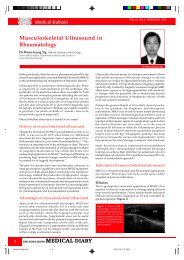MEDICAL DIARY - The Federation of Medical Societies of Hong Kong
MEDICAL DIARY - The Federation of Medical Societies of Hong Kong
MEDICAL DIARY - The Federation of Medical Societies of Hong Kong
Create successful ePaper yourself
Turn your PDF publications into a flip-book with our unique Google optimized e-Paper software.
22<br />
Introduction<br />
Special Feature<br />
New Childhood Immunisation Programme<br />
in <strong>Hong</strong> <strong>Kong</strong><br />
Dr. Daniel KL Cheuk<br />
MBBS, DCH (<strong>Hong</strong> <strong>Kong</strong>), DCH (International), MRCPCH, MMedSc, FHKAM (Paed), PDipID<br />
Department <strong>of</strong> Paediatrics and Adolescent Medicine, <strong>The</strong> University <strong>of</strong> <strong>Hong</strong> <strong>Kong</strong><br />
In Feb 2006, the Department <strong>of</strong> Health in <strong>Hong</strong> <strong>Kong</strong><br />
started to implement a new universal immunisation<br />
programme for children. <strong>The</strong> old and new immunisation<br />
schedules are shown in Table 1. In the new programme,<br />
oral polio vaccine (OPV) is replaced by inactivated polio<br />
vaccine (IPV) and whole cell pertussis vaccine (wP) is<br />
replaced by acellular pertussis vaccine (aP). In addition,<br />
vaccines against diphtheria, tetanus, pertussis and<br />
poliovirus are given as a combined quadruple vaccine<br />
(DTaP-IPV) instead <strong>of</strong> separate DTaP and IPV vaccines.<br />
In this article we shall review the rationale behind and<br />
evidence supporting the change in the immunisation<br />
programme. We shall also briefly review other<br />
combination vaccines widely used in private sector in<br />
<strong>Hong</strong> <strong>Kong</strong>, as well as the differences between our local<br />
childhood immunisation programme and that <strong>of</strong> the<br />
United States and the United Kingdom.<br />
IPV vs OPV<br />
<strong>The</strong> Salk formalin-inactivated polio vaccine and the<br />
Sabin live-attenuated oral polio vaccine were licensed in<br />
the US in 1955 and 1961 respectively. Though<br />
developed later, OPV soon replaced IPV in most<br />
countries as it is inexpensive, requires no needle,<br />
produces mucosal immunity and herd immunity. More<br />
than 95% <strong>of</strong> recipients develop long-lasting immunity<br />
to all 3 types <strong>of</strong> poliovirus after 3 doses <strong>of</strong> OPV. On the<br />
other hand, the immunogenicity <strong>of</strong> the original IPV was<br />
low and was replaced in 1988 by enhanced-potency IPV<br />
which has greater antigenic content. Both IPV and OPV<br />
induce mucosal immunity <strong>of</strong> the gastrointestinal tract,<br />
but that induced by OPV is superior, 1 though<br />
pharyngeal mucosal immunity is comparable for both<br />
vaccines. Herd immunity induced by the spread <strong>of</strong> the<br />
live polioviruses <strong>of</strong> OPV <strong>of</strong>fers distinct advantage and<br />
contributes to the global eradication <strong>of</strong> poliomyelitis.<br />
Routine and mass administration <strong>of</strong> OPV in the past 40<br />
years has markedly reduced the incidence <strong>of</strong> paralytic<br />
poliomyelitis in most parts <strong>of</strong> the world as well as in<br />
<strong>Hong</strong> <strong>Kong</strong>; and OPV is still the type <strong>of</strong> polio vaccine<br />
recommended by WHO for eradication <strong>of</strong> polio in<br />
endemic countries. Although the public health benefit<br />
<strong>of</strong> OPV is enormous, there is a trend in the switch <strong>of</strong><br />
OPV to IPV in many developed countries because OPV<br />
is associated with a severe adverse effect, namely<br />
vaccine-associated paralytic poliomyelitis (VAPP),<br />
which occurs in approximately 1 per 1.4 million OPV<br />
doses in England 2 and 1 per 2.5 million doses in the<br />
VOL.12 NO.7 JULY 2007<br />
Dr. Daniel KL Cheuk<br />
US 3 Apart from VAPP, vaccine-derived poliovirus can<br />
be excreted in faeces and cause outbreaks <strong>of</strong><br />
poliomyelitis. 4<br />
After eradication <strong>of</strong> poliomyelitis in the US since 1979,<br />
the risk for VAPP is considered to outweigh its benefits.<br />
Consequently, in 1997, the US Advisory Committee on<br />
Immunization Practices (ACIP) recommended replacing<br />
the all-OPV schedule with a sequential schedule <strong>of</strong> IPV<br />
followed by OPV to decrease the risk for VAPP while<br />
maintaining the benefits <strong>of</strong> OPV. This sequential<br />
schedule was accepted with no decline in immunisation<br />
coverage despite the need for additional injections. In<br />
2000, ACIP went on to recommend exclusive use <strong>of</strong> IPV<br />
to eliminate the risk <strong>of</strong> VAPP. However, ACIP reaffirms<br />
OPV as the only vaccine recommended to eradicate<br />
polio from endemic countries. Based on similar<br />
circumstances and rationale, <strong>Hong</strong> <strong>Kong</strong> has now<br />
switched to IPV for universal childhood immunisation.<br />
Studies have confirmed that 99%-100% <strong>of</strong> children<br />
develop protective antibodies after administration <strong>of</strong><br />
three doses <strong>of</strong> IPV. 5 <strong>The</strong> response is not inferior to<br />
OPV in a randomised controlled trial. 6 In addition,<br />
more than 90% <strong>of</strong> vaccinated persons have serum<br />
antibodies 25 years after the fourth dose. 7 Although<br />
there is no direct evidence that IPV is equally effective<br />
as OPV in preventing outbreaks <strong>of</strong> poliomyelitis,<br />
switching from OPV to IPV is considered unlikely to<br />
result in resurgence <strong>of</strong> poliomyelitis given the current<br />
eradication <strong>of</strong> polio in our locality. Furthermore, an<br />
extensive review has not found any serious adverse<br />
event caused by IPV. 8 <strong>The</strong>refore, switching from OPV<br />
to IPV in <strong>Hong</strong> <strong>Kong</strong> is likely to have a good riskbenefit<br />
ratio, and experience from the US has shown<br />
that vaccine uptake is unlikely to be compromised by<br />
the switch.<br />
Acellular vs Whole cell pertussis<br />
vaccine<br />
Vaccines made from killed whole Bordetella pertussis<br />
organisms have been available since the 1950s.<br />
However, whole cell pertussis vaccines have many<br />
adverse effects which include reactions such as fever,<br />
irritability and injection site pain commonly, and<br />
transient severe reactions such as hypotonichyporesponsive<br />
episodes, convulsions and acute<br />
encephalopathy rarely. Acellular pertussis vaccines<br />
containing purified or recombinant Bordetella pertussis<br />
antigens instead <strong>of</strong> intact organisms have been
















